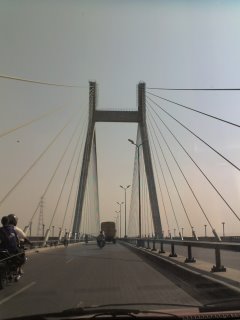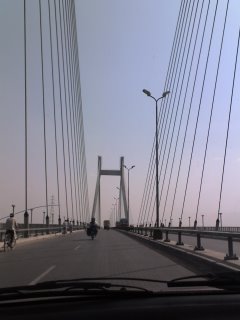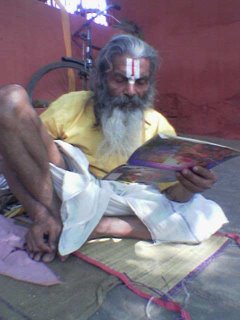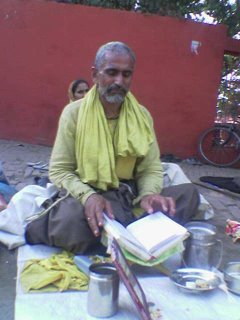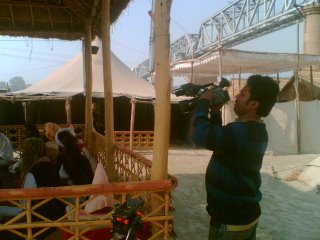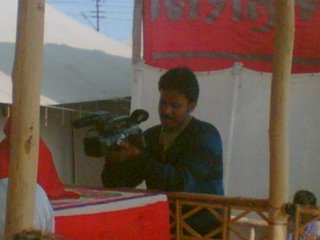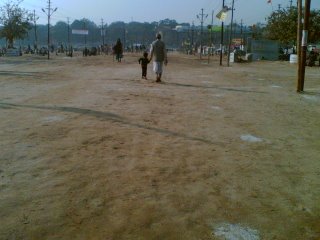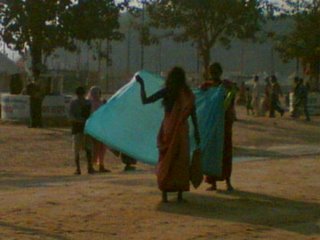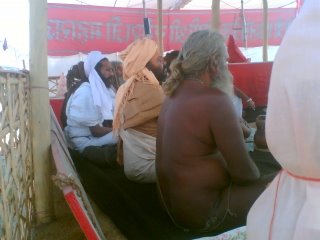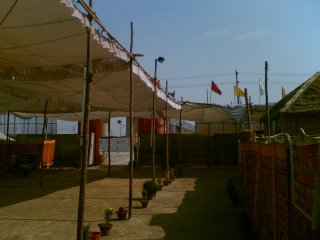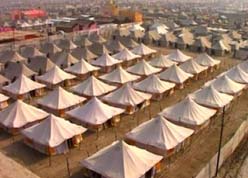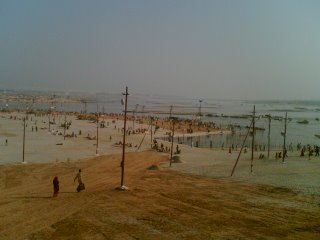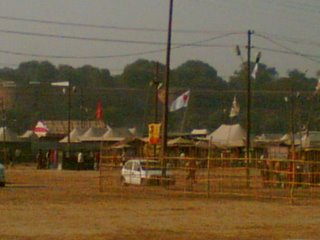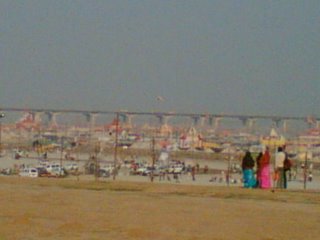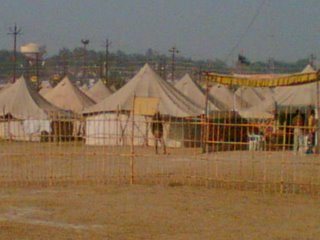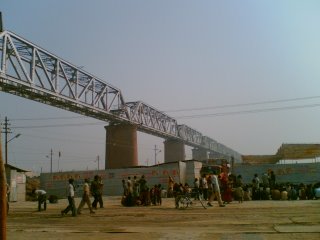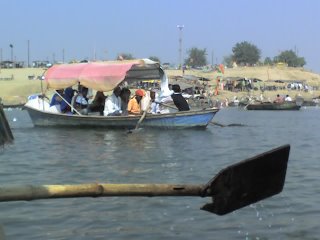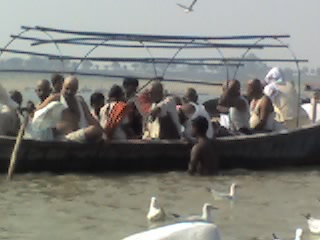anyworld
Tuesday, January 16, 2007
CHILLUM JOURNEY



Ardh Kumbh mela goes beyond devotion, the colours, the songs in Allahabad.
The Sadhus an integral part of the spiritual journey and the biggest attractions in the mela are smoking Chillums in the name of God.
As dusk settles at the Kumbh smoke rises from the akharas mingling with the dust motes hovering over the fairgrounds. After a day of social interaction and public worship its time for another kind of communion.
The sadhus particularly the Naga Babas withdraw into akharas and silence."Babas smoke for their meditation and prayers. Like everyone has tea and rotis, mahatmas get into the habit of smoking the chillum.
Everyone has it but we have more here because of the fair," said Naga Mahant Saraswati. It is an old tradition amongst the followers of Lord Shiva and at the Kumbh most visible and prominent at the Sanyasi akharas.
"The chillum and the ganja is not the tradition of any one akhara, it's a personal thing and all the sadhus and babas don't smoke in front of their gods and deities," Mahant Raghumani, Sri Panchayati Bada Udasin Akhara.
"Every akhara has its own gods and deities. The reason for smoking this has been to help concentrate on their meditation but even that has its limits," he added. So while it's an open practice at some akharas like the Juna akhara others like the Bada Udasin Akhara like to keep it private.
There's a huge demand at the Kumbh both for cannabis and its preferred vehicle, the Chillum.Vendors like Neeraj get chillums from nearby Bihar and sell more than 100 a day for Rs 1 apiece.
As for cannabis the babas have it all."We sell many and they still run short. The babas buy them en masse," said Neeraj Gupta.
What is for many sadhus and babas an integral part of their spiritual journey is in popular culture, a completely different trip.
Saturday, January 13, 2007
Spiritual High

Picx Courtesy: PK DAS
Inside the tents on the banks of river Ganga, as part of the Ardh Kumbh Mela, is practised a special way of life. Devotees sing bhajans and keertans (hymns) all day long, eat restricted diet and sleep on the ground.
This life philosophy, called Kalpvaas, is known to be followed only in Prayagraj, the city of Allahabad.
“The main thing is how you can control your psycho or bio system. After Kalpvas, they feel some balancing of the chemicals,” says Swami Avdhesha Nand.
The popularity of the term, which is not new for the Indian devotee, is rising among visitors from across the world. Balkrishan, a devotee from England is practicising Kalpavaas at the Kumbh this time.
“We live very simply. And in that way of living simple we can concentrate more on Krishna, Ganga, Jamuna and Saraswati,” says Balkrishana.
Even Sanak Sanatan who is also from England can rattle off quotes from books on Kalpvaas.
“In order to purify your soul, we should stay on the banks of Mother Ganga for atleast one month,” says Sanak Sanatan.
Robert from Poland, who like many visitors to the Kumbh, had come in search of enlightenment. But he discovered Kalpavaas instead.
“It’s supposed to be austere. But I’m having a lot of fun. It seems quite hard getting up in the morning. But I accept this. It’s nice being part of the Indian culture and having the Krishna prasad,” says Robert
Kumbh is a motley of different kinds of Kalpvaasis where most of them come in search of purity of the being.
But there are also many others for whom this one month of tent life is all about picnic, business and missed opportunities getting rediscovered.
NY
Friday, January 12, 2007
FRIENDS IN DOHA

BOSCO & RAZZAK
Two Indians who reside in Doha (host city of the 15th Asian Games). They work for BATES PANGULF PR firm, the agency that handled the PRESS affairs for DAGOC. It was a pleasure to meet these two guys as they helped me immensley in my trip and went out the way to get things organised.
Bosco MENEZES (Blue shirt) hails from Mumbai and is an ardent hockey fan. However, the national game of India does not an assocation in Qatar and along with some friends are trying to help the game find some takers. Did visit his team and his concrete rink hockey ground in Doha. It includes Malaysians, Indians and some local guys playing hockey together over the weekend. Bosco is a keen follower of the game and his teammates were happy to help us out.
ABDUL RAZZAK ( SLim GUY) hails from HYDERABAD and is the juniormost PR person in DOHA. at 21 handling the ASIAN GAMES Is no easy task and he is a perfectionalist in organising things. He loves Hyderabadi biryani and is a ardent fan of SANIA MIRZA and SALMAN KHAN. However, Bosco was given the chance to handle press for Sania and it caused envy in Razzak's heart but he is a great sport.
the tow guys deserve a mention on my blog as they were two good friends that i came acorss during my visit across the globe. Wish them luck and all success in their future programmes.
FUTURE WORRY



The Ardh Kumbh Mela is attracting hundreds of sadhus. But what draws them to the holy event?
A sanyasi for the past 60 years, Mahant Rameshwar Tyagi does not believe in it anymore. He has realised that being a sadhu has not taken him anywhere.
He wants to give up his sadhuhood and now Tyagi is running after astrologers at the Kumbh Mela to know his future.
“I do not wish to be a sadhu in my next birth. It is not worth it,” says Tyagi.
Head covered with a white cloth, and sporting a beard, sadhu Brahmacharya Das is very open about the questions he's asking his astrologer.
“I want to know when I will be able to establish my math,” asks Das.
Yogis visiting the Kumbh Mela feel that there is an increase in the number of sadhus who give greater priority to their personal needs and wants.
“Everyone whether a sadhu or not is worried about his future,” says an astrologer, Rameshji Maharaj.
Considering the future is not only the concern of you and me but also of those who renounce the world and talk about worldly detachment, it's perhaps time we change our views about the saffron clad and matted hair mystics.
Thursday, January 11, 2007
RAMDEV YOGA LESSONS FOR ALLAHABAD
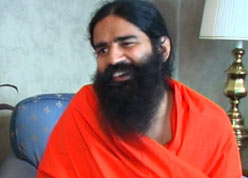
Baba Ramdev is perhaps one of India's most multi-faceted gurus, teaching yoga in the first half of the session, followed by marketing lessons in the second half.
"I am a marketing guru. There's no harm in marketing yoga. It's a matter of great pride for me," says he.
The Baba is well aware of the enormity of the Kumbh Mela and, therefore, he doesn't miss the chance to talk about his new yoga college.
"The first phase of work of our college is over. The work on second phase is going on. I want to make 'right breathing' a medical remedy," he says.
And to top it all, he is also a holding a session with the media, so that at least this time round, the media does not go back unhappy.
Lalu Prasad before the management students and now Baba Ramdev before the devotees of the Kumbh mela - believe it or not, the world's biggest congregation has become an elaborate platform for the management and the PR exercises of all the saints.
SECURITY AT KUMBH TIGHTENED
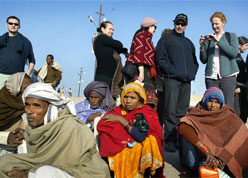
Security measures were tightened and paramilitary forces deployed at the world's biggest congregation, the Ardh Kumbh Mela in Allahabad on Friday, after a terror warning was received by the intelligence services of Delhi and Mumbai.
According to intelligence sources, Jaffer the suspected mastermind behind Mumbai’s 7/11 blasts is in Allahabad posing serious threat during the Kumbh festivities.
While there were reports that a rough sketch of the suspect was doing rounds at the congregation, Allahabad SSP denied having any knowledge of it.
Responding to the unconfirmed reports, SSP said, “We have not released any sketch. However additional security arrangements has been made in the area. Paramilitary forces have been deployed and the security set up has been tightened. Even an aerial vigil is on," said Rajeev Sabharwal SSP, Allahabad.
The mela administration has not taken any chances with the security. More than 10,000 police personnel have been deployed, bunkers made and the mela boundaries well guarded.
NEW OFFERINGS TO GOD

Sadhus, who travel from their destinations to the Ardh Kumbh, have to no temple to visit on the sandy banks of the River Ganga.
However, they have now found a solution to their problem. The sadhus have a makeshift temple on the banks. And with the Ardh Kumbh spanning 41 days, wherever the sadhus go, their deities travel with them.
“We need to worship our deities everyday and so we have to travel with them,” says head of Juna akhada, Swami Avdheshanand.
The temple too has got a makeover with time. So while, conches and tridents still remain the favourites of the sadhus, there are some unconventional offerings like a teddy bear, a cricket bat and even a ball that is offered to the deities.
And if you are looking for a divine connection, you can call on a mobile phone or a landline too.
However, that’s not all. There’s also a letterbox to snail mail your prayers to the Gods, and a chopper and a car to drive home the point.
“We offer computers, laptops and helicopters to please gods,” says Swami Avdheshanand
However, one should not think that its just gizmos all the way. A conventional aarti is also held every day.
And by the end of the Kumbh Mela the mobile temple will be dismantled and the articles on the throne would go back to their original places of worship.
COMMERCE BEHIND PITCHER FESTIVAL
ARDH KUMBH held once in six years, this grand pitcher festival is known for its most auspicious bathing days like Makar Sankranti and Maha Shivratri, which mark the end of the Ardh Kumbh.
It is said that on any of these days, the number of devotees is almost equivalent to the population of California.
Managing such a huge crowd is a tough exercise for the administration. Just take a look at the logistics involved:
A budget of Rs 170 crore for one month is allocated to eight different departments, which divide the entire area into 11 sectors.
The river bank is connected through 14 pontoon bridges and 27 smaller bridges.
One cannot travel on sand, therefore 75 kms of chequered plates, carpeted all across, lights through 17,000 electric posts, 14 health centres, and drinking water for lakhs of devotees.
"here are 38 tubewells and 220 kms of water pipeline to provide drinking water to the devotees
This is the biggest attraction for sadhus who have already started coming in from far and wide to take part in this period of enlightenment. These sadhus are more than 5 lakh in numbers, but are divided into 13 akhadas (sects)
The Kumbh administration is expecting nearly seven crore devotees this years
TUG OF WAR: KUMBH STYLE
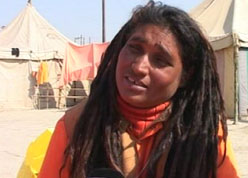
Their fashionable façade may just be a cover up, but hidden under that façade are stories of male domination.
Yet the sadhvis (female sadhus) aspire to become great preachers on stage.
While some sadhvis like Sadhvi Prema Pandurang of South India, Sadhvi Rithambhra of Vrindavan and Mata Kanteshwari of Gujarat are already in the reckoning, among them, not all reach such heights.
This was the issue at hand for a group of sadhvis who had assembled at the Kumbh Mela site.
“Sadhvis are oppressed. Even on the stage the sadhus don't give them a chance,” says Sadhvi Nitya.
The story however, is not just limited to India. Sadhvi Aradhanagiri of Bangladesh, who also aspires to be a popular preacher and does not hesitate to say so, faces the trauma.
When asked if she regrets not being able to get the same popularity as her male counterparts, she says, “I do. But it does not happen for us.”
According to the Sadhvi Shakti Parishad, an organisation of the sadhvis, there are 2.5 lakh sadhvis in India.
And even the organisation feels quite concerned about the male domination of sadhus.
But when sadhus are questioned about this, they start preaching humility.
"We treat the sadhvis well. They are always given a chance. Get a sadhvi and see how we treat her on stage,” says Mahantram Kewaldas Sadhu.
But the story is not the same if you come down to the Malwada area of the Ardh Khumb Mela where the sadhvis stay.
However, that's not the end. The story of the male domination of the sadhus state extends to many more stories of oppression and sadness.
WRESTLE MANIA: KUMBH STYLE

The world's biggest congregation, the Ardh Kumbh Mela which begins in Allahabad on Wednesday, is never complete without the Akhada sadhus.
An akhada (a place where a wrestling bout is held) is usually a place for wrestlers, but at the Kumbh, the players are none other than the sadhus.
The goal of the akhadas, some more than 1,500 years old, is to protect the Hindu religion.
“There are 13 akhadas in all in our country. The first few akhadas were set up Shankaracharya,” says Mahant govindachrya Bhramachari, Agni Akhada.
The biggest of the akhadas is the Juna akhada which has more than 60 lakh sadhus. Of all the sadhus, the Naga sadhus are the most popular and visible as they are more aggressive and carry weapons.
“We'll retaliate with weapons if the need arises,” says Mahant Rajabharti of Juna Akhada.
Life at an akhada is a sharp contrast of colour and austerities. If you walk inside and take a look, you can spot a sadhu wearing 21,000 rudraksh beads. He says he has come way from the mountains, and claims to survive on herbs. But here he teaches how to prepare marijuana pipes.
Inside the akhada, one stumbles upon sadhus of foreign origin too. But what do they like most about life in akhadas? “There is a feeling of togetherness, guru, life,” says Arjun Bharti of Aawahan Akhada.
The story if akhadas is actually incomplete without the colours. You feel an extremely overpowering energy once you walk inside. The sadhus inside the akhadas may be worshipping different deities and incarnations. But their aim is the same – purity of mind and purity of soul.
BRIEF ON KUMBH MELA
Hundreds of thousands of yogis, sadhus and pilgrims come to take a holy dip in the Ganges during this important Hindu spiritual gathering.
Legend has it that before the universe took shape, the gods and demons churned the waters--as a result of which--from the ocean arose Dhanvantari carrying in his hands a kumbha (pot) of nectar. As the gods and demons struggled for possession of this precious liquid, drops fell at 12 places in the world. Four of these, Allahabad, Nasik, Haridwar and Ujjain are in India and this fair (mela) is held in each of these places in a twelve year rotating cycle.
The largest and most famous one occurs in Allahabad once every 12 years. This is called the Maha Kumba. the first in the century was in 2001 and will return in 2013






